
Crawfordsville is a city in Montgomery County in west central Indiana, United States, 49 miles (79 km) west by northwest of Indianapolis. As of the 2020 census, the city had a population of 16,306. The city is the county seat of Montgomery County, the only chartered city and the largest populated place in the county. It is the principal city of the Crawfordsville, IN Micropolitan Statistical Area, which encompasses all of Montgomery County. The city is also part of the Indianapolis–Carmel–Muncie, IN Combined Statistical Area.
Western Electric Co., Inc. was an American electrical engineering and manufacturing company that operated from 1869 to 1996. A subsidiary of the AT&T Corporation for most of its lifespan, Western Electric was the primary manufacturer, supplier, and purchasing agent for all telephone equipment for the Bell System from 1881 until 1984, when the Bell System was dismantled. Because the Bell System had a near-total monopoly over telephone service in the United States for much of the 20th century, Western Electric's equipment was widespread across the country. The company was responsible for many technological innovations, as well as developments in industrial management.

The Ford Piquette Avenue Plant is a former factory located within the Milwaukee Junction area of Detroit, Michigan, in the United States. Built in 1904, it was the second center of automobile production for the Ford Motor Company, after the Ford Mack Avenue Plant. At the Piquette Avenue Plant, the company created and first produced the Ford Model T, the car credited with initiating the mass use of automobiles in the United States. Prior to the Model T, several other car models were assembled at the factory. Early experiments using a moving assembly line to make cars were also conducted there. It was also the first factory where more than 100 cars were assembled in one day. While it was headquartered at the Piquette Avenue Plant, Ford Motor Company became the biggest U.S.-based automaker, and it would remain so until the mid-1920s. The factory was used by the company until 1910, when its car production activity was relocated to the new, larger Highland Park Ford Plant.

The Endicott-Johnson Shoe Company ("E-J") was a prosperous manufacturer of shoes based in New York's Southern Tier, with factories mostly located in the area's Triple Cities of Binghamton, Johnson City, and Endicott. An estimated 20,000 people worked in the company's factories by the 1920s, and an even greater number worked there during the boom years of the mid-1940s when, helped by footwear it produced for the military during the war years, it was producing 52 million pairs of shoes a year. During the early 1950s, the work force was still approximately 17,000 to 18,000. Today, EJ Footwear, LLC operates as a unit of Nelsonville, Ohio-based Rocky Shoes & Boots, Inc.

Pullman National Historical Park is a historic district located in Chicago, Illinois, United States, which in the 19th century was the first model, planned industrial community in the United States. The district had its origins in the manufacturing plans and organization of the Pullman Company and became one of the most well-known company towns in the United States, as well as the scene of the violent 1894 Pullman strike. It was built for George Pullman as a place to produce the Pullman railroad-sleeping cars.
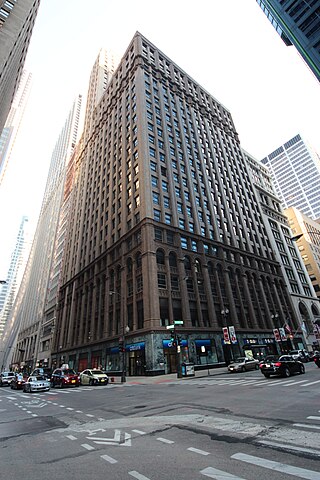
11 South LaSalle Street Building or Eleven South LaSalle Street Building is a Chicago Landmark building that is listed on the National Register of Historic Places and that is located at 11 South LaSalle Street in the Loop community area of Chicago, Illinois, United States. This address is located on the southeast corner of LaSalle and Madison Street in Cook County, Illinois, across the Madison Street from the One North LaSalle Building. The building sits on a site of a former Roanoke building that once served as a National Weather Service Weather Forecast official climate site and replaced Major Block 1 after the Great Chicago Fire. The current building has incorporated the frontage of other buildings east of the original site of Major Block 1.

The Brown Shoe Company Factory is a historic factory located at 212 S. State St. in Litchfield, Illinois. The factory opened in 1917 to produce shoes for the St. Louis–based Brown Shoe Company. Prominent St. Louis architect Albert B. Groves designed the factory, which was one of twelve he designed for the company. The factory became Litchfield's second-largest industry and brought the community prosperity through the Great Depression; in addition, its employees formed a civic organization that created a public park on company property. The factory closed in 1967; it was later used by cabinet manufacturer Adenca.
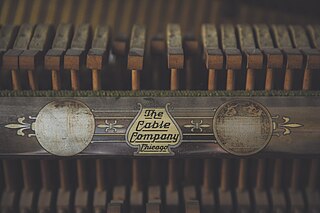
The Cable Company was an American manufacturer and distributor of pianos and reed organs that operated independently from 1880 to 1936.

The Dawson Brothers Plant is a historic factory building located at 517-519 N. Halsted Street in the West Town community area of Chicago, Illinois. The factory was built in 1888 and designed by Julius Zittel; the five-story brick building has a cast iron front on its first floor and lacks ornamentation. The Dawson Brothers used the factory to produce fireplace mantels and grates; the building also served as the company's showroom and offices. A six-story addition was added to the building in 1901; this addition mainly served as a storage and shipping area. The Dawson Brothers conducted business at the factory until the 1920s. The building was added to the National Register of Historic Places on February 14, 1985.
Seneca Glass Company was a glass manufacturer that began in Fostoria, Ohio, in 1891. At one time it was the largest manufacturer of blown tumblers in the United States. The company was also known for its high-quality lead (crystal) stemware, which was hand-made for nearly a century. Customers included Eleanor Roosevelt and Lyndon B. Johnson, and retailers such as Marshall Field and Company, Neiman Marcus, and Tiffany's.

The Kimball Brothers Shoe Factory is a historic factory building at 335 Cypress Street in Manchester, New Hampshire. The four-story brick building was built in stages between 1885 and 1900, and was a prototypical structure from which the design of other period shoe factories in Manchester were built. Construction was overseen by Head & Dowst, a builder responsible for a number of area public buildings, including schools and prisons. It was funded by local businessmen seeking to diversify the local economy, and was leased to the Kimball Brothers, a leading shoe manufacturer in Lynn, Massachusetts. The building was listed on the National Register of Historic Places in 1985.

The historic Chicago park and boulevard system is a ring of parks connected by wide, planted-median boulevards that winds through the north, west, and south sides of the City of Chicago. Neighborhoods along this historic stretch include Logan Square, Humboldt Park, Garfield Park, Lawndale, Little Village, McKinley Park, Brighton Park, Gage Park, Englewood, Back of the Yards, and Bronzeville. It reaches as far west as Garfield Park and turns south east to Douglass Park. In the south, it reaches Washington Park and Jackson Park, including the Midway Plaisance, used for the 1893 World's Fair.
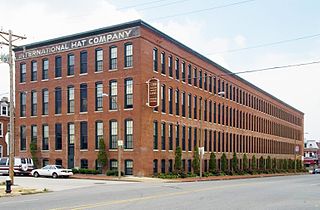
Brown Shoe Company's Homes-Take Factory, also known as the International Hat Company Warehouse, is a historic building location at 1201 Russell Boulevard in the Soulard neighborhood of St. Louis, Missouri. Built in 1904, by renowned architect Albert B. Groves, the building was originally a factory for the Brown Shoe Company, based in St. Louis. In 1954, the factory was subsequently converted into a warehouse by the International Hat Company. The site has been recognized as a testament to Grove's architectural expertise in the principles of factory design, namely technical advances in layout planning, operational efficiency, and employee safety. Additionally, the factory epitomizes the early 20th century cultural transformation and socio-industrial development of St. Louis into a manufacturing powerhouse. In particular, the Brown Shoe Company is recognized as a principal player in challenging the 19th century dominance of the New England shoe industry. This significantly contributed to the early 20th century sobriquet of St. Louis as the city of "shoes, booze, and blues." The Brown Shoe Company's Homes-Take factory is considered to be among the pioneering industrial facilities of this historic transformation.

The A. M. Rothschild & Company Store, also known as the Goldblatt's Building, is a historic department store building located at 333 South State Street in the Loop neighborhood of Chicago, Illinois.

The Otis Elevator Company Factory Building is a historic industrial building located at 1435 W. 15th Street in the Near West Side neighborhood of Chicago, Illinois. The Otis Elevator Company had the factory built in 1900. The company, then the nation's largest elevator manufacturer, sought to grow its sales in Chicago, as the city's growth and numerous new skyscrapers made it a profitable market for elevators. The Chicago firm of Adler & Treat designed the factory as a brick building with Colonial Revival elements. The factory served as a regional headquarters until 1914, when Otis restructured and introduced smaller regional offices; while it continued to have a Chicago office, it sold the factory building. The Riley-Schubert-Grossman Company, a wholesaling firm, purchased the building in 1916; while it only occupied the building for a short time, its extensive remodeling gave it its present-day layout.
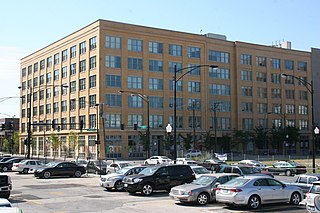
The Automatic Electric Company Building, located at 1000 W. Van Buren Street in Chicago, Illinois, is the original headquarters of the Automatic Electric Company. The company developed and popularized the automatic telephone exchange in the early 20th century. Inventor Almon Strowger had begun producing and selling automatic switches in the 1890s, but never had a permanent factory; when he helped form the Automatic Electric Company in 1901, the company constructed the building on Van Buren as a factory and headquarters. As Illinois Bell, the largest telephone company in Chicago, did not wish to contract with them, the company grew its market by selling to smaller independent telephone companies in the city. Over the next two decades, it expanded to national and then international customers, and after an employee strike in 1919 the Bell System ultimately became a customer as well. The company used the building as its headquarters until 1957, when it moved to a complex in Northlake.

The Storkline Furniture Corporation Factory was a historic factory building at 4400-4418 W. 26th Street in the South Lawndale neighborhood of Chicago, Illinois. The Storkline Furniture Corporation, a nationally popular children's furniture company, produced all of its furniture at the factory. Founded in 1915 as the Glass Novelty Company, the corporation renamed itself after its most popular product in the 1920s and built a new factory in 1925. Chicago architect Sidney Minchin designed the brick building, incorporating Sullivanesque terra cotta decorations in the facade. As one of the only companies specializing in children's furniture, Storkline dominated the market in the 1920s and 1930s, and it saw continued success in the following decades. It produced furniture at the factory until another furniture company bought the corporation in the 1960s.
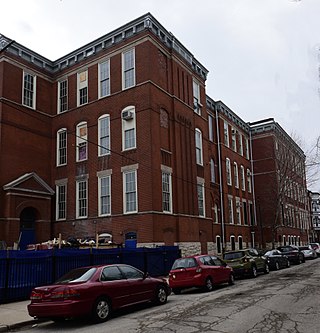
The John Lothrop Motley School is a historic school building at 739 N. Ada Street in the West Town neighborhood of Chicago, Illinois. It was built in 1884 to serve the growing neighborhood, as an influx of immigrants and Illinois' 1883 Compulsory Education Law had greatly increased its student population. John J. Flanders, who became chief architect of the Chicago Board of Education in 1884, designed the school according to a standardized plan which was used throughout the city. The Renaissance Revival school has an asymmetrical layout and includes several small side entrances, ornamental brickwork on its chimneys, and a metal cornice. Flanders' design was a stark change from the symmetrical Italianate plans of earlier Chicago public schools. The district's student population continued to increase in the following decades, and the Board of Education built an addition onto the school in 1898 as a result. The school operated continuously until closing in 2013.

Ely Walker Lofts is a building located at 1520 Washington Avenue in St. Louis, Missouri.
The M.C. Kiser Company Building is a historic building in Atlanta, Georgia, United States. Located in the South Downtown neighborhood, it was built in 1923 as a shoe factory, converted to apartments in 2017, and added to the National Register of Historic Places in 2019.



















